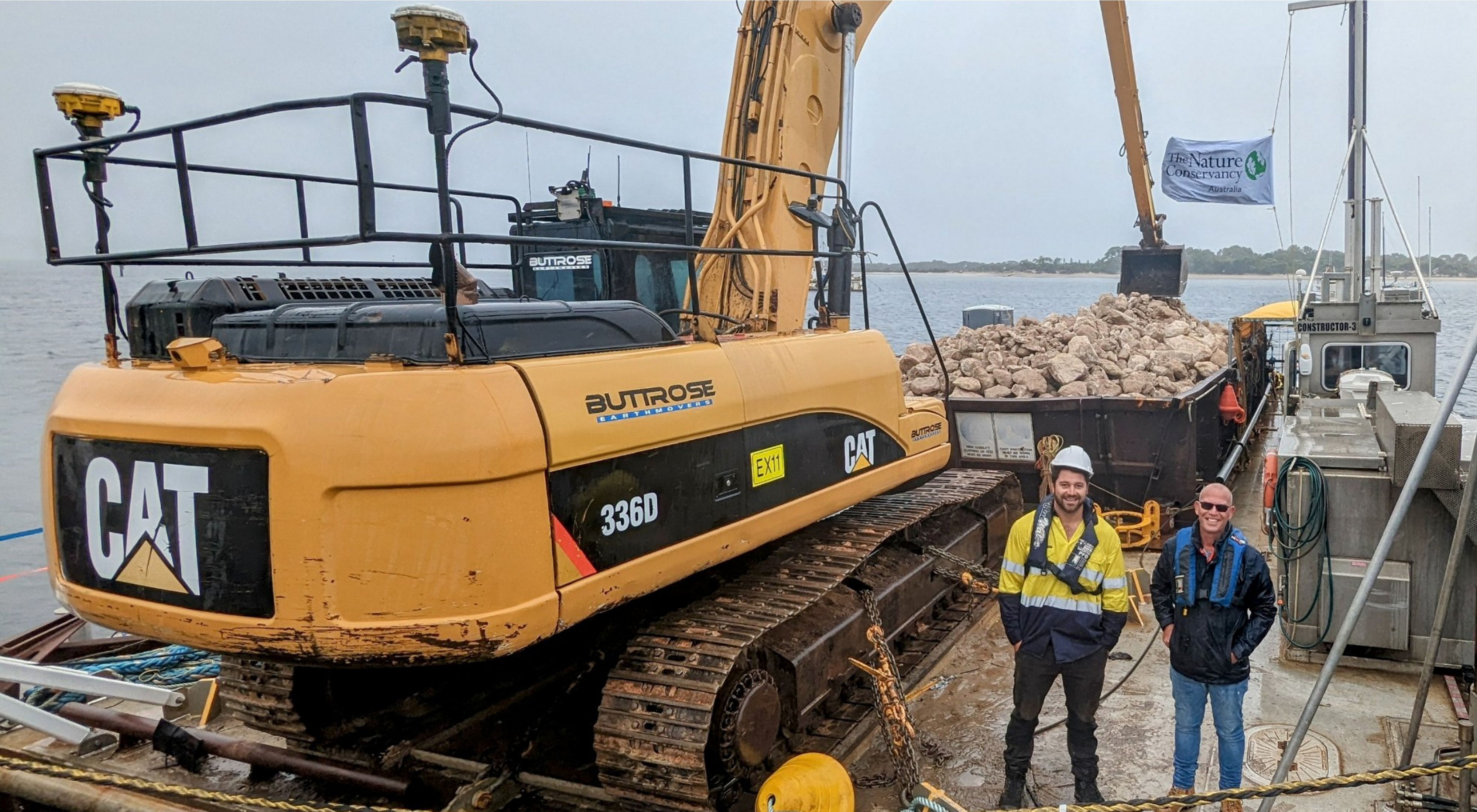Media Contacts
-
Vanessa Billy
Communications Manager
The Nature Conservancy Australia
Phone: 0478 638 180
Email: vanessa.billy@tnc.org
The Nature Conservancy Australia (TNC) announced today a reef restoration project off the Kangaroo Island coast to benefit the local marine environment and community.
The Kangaroo Island shellfish reef restoration project will restore a 3-hectare shellfish reef 3 kilometres from the coast in the eastern cove of Nepean Bay.
Kangaroo Island is one of 13 sites identified for restoration under the Reef Builder program, a partnership between the Australian Government and TNC to bring shellfish reefs back from the brink of extinction and support the economic recovery of communities impacted by bushfires and COVID-19 restrictions.
“Australians know that protecting and restoring our natural environment is essential for our future. This project will help to bring native shellfish reefs back from the brink of extinction, as well as support the local Kangaroo Island community”, Minister for the Environment and Water, Tanya Plibersek, said.
“Restored shellfish reefs will ensure there are more fish, cleaner water and greater opportunities for recreational fishing and tourism. This is especially important for the Kangaroo Island community that has seen huge impacts from bushfires and the coronovirus pandemic,” Minister Plibersek said.
The project has also received generous philanthropic support from The Terra Artemis Foundation, the Daisy and Edward Mallett Foundation as well as a private philanthropic grant.
Across South Australia, TNC is working with the Australian Government, the South Australian Department for Environment and Water and a range of local agencies to help bring lost shellfish reefs back along South Australia's coastline.
In doing so, it will help build a better future for people and nature: restored shellfish reefs will ensure there are more fish, cleaner water and greater opportunities for citizen science, recreational fishing and tourism.
“We are very excited to work with the local community and with the support of the Kangaroo Island Council on this fantastic project which will help return native Australian Flat Oyster reef ecosystems back to the bays of Kangaroo Island,” TNC’s South Australia Oceans Manager, Anita Nedosyko, said.
Minister for Climate, Environment and Water Susan Close said the project was a fantastic initiative helping to restore marine environments in South Australian waters.
“It’s exciting to mark the start of the fourth shellfish restoration reef built in South Australia, in collaboration between The Nature Conservancy and the Department for Environment and Water. This initiative has been long supported by the South Australian Government,” Dr Close said.
“Shellfish reefs were once common along our coastlines. However, since the late 1800s, these reefs suffered from the effect of overfishing, dredging, water pollution and disease.
“They play a vital part in providing habitats in marine environments, which is important for fish breeding, and water quality, so it’s wonderful to see the restoration of a fourth reef begin.”
The first stage of the restoration project, starting at the end of January, will be to lay the foundation of the reef with locally-sourced rocks using a barge and a long-reach excavator.
Upon completion, which will take approximately one month, divers will seed the rock foundation with over 3 million juvenile Australian Flat Oysters to kick-start the reef recovery process.
A proportion of these oysters are being grown on Kangaroo Island as part of Australia’s first remote oyster setting trial. The oyster larvae were reared in October 2022 at the South Australian Research and Development Institute in Adelaide, using broodstock collected from the island. After four weeks, the oyster larvae were moved to American River in Nepean Bay and set on clean recycled oyster shells.
The team at the Kangaroo Island Shellfish aquaculture farm, led by Managing Director Ken Rowe, are assisting in the reef building process by helping TNC grow Australian Flat Oysters at American River. They are also developing a tourism hub on the island to highlight the restorative and commercial potential of this native shellfish species.
“We are excited to be part of TNC’s shellfish reef restoration project on Kangaroo Island. Besides the satisfaction of contributing where we can to the many benefits of such a project, it also fits well with our strategic vision around promoting a native oyster industry on the Island,” Mr Rowe said.
“Oysters are powerful at filtering water and the reef will also provide habitat for a range of key fish species including snapper, whiting, leatherjackets, cuttlefish and squid. Once matured, these shellfish reefs will provide new fishing and diving locations for the Kangaroo Island community,” Ms Nedosyko said.
Shellfish reefs are part of South Australia’s natural heritage: they once thrived across the coastline, including the bays of Kangaroo Island, providing homes, food and breeding grounds for hundreds of marine species. Today they are on the brink of extinction due to a combination of overfishing, pollution and diseases, with the many benefits they provide to nature and coastal communities also under threat.
“The good news is that, with the right partnerships and support, we can bring these native shellfish ecosystems back from near extinction, as well as other vital ecosystems such as seagrass, mangroves, saltmarsh and kelp,” said Ms Nedosyko. “TNC has experience restoring shellfish reefs across the globe and is actively working on restoring these precious ecosystems in Queensland, New South Wales, Victoria, Tasmania, South Australia and Western Australia.”
The Nature Conservancy is a global conservation organisation dedicated to conserving the lands and waters on which all life depends. Guided by science, we focus on getting things done efficiently and with the greatest positive impact for conservation. We’re a trusted organisation working in more than 70 countries and territories around the world on innovative solutions to our world’s toughest challenges so that nature and people can thrive together. To learn more about The Nature Conservancy in Australia, follow us on Facebook.
